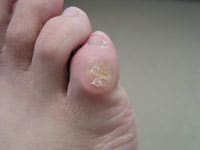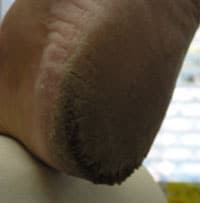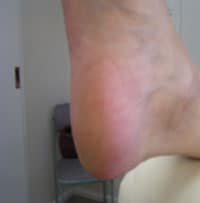Common Conditions
Heel pain, FLAT FEET, callous, ingrown toenails, plantar warts or shin splints can all be debilitating conditions. What are CORNS? How do I get rid of tinea? In this section we reveal the truth about some of these conditions, in easy to understand language – not confusing medical jargon. Provided is a brief overview. This should never be misconstrued as a replacement for a consultation with one of our professionally qualified podiatrists. Please contact our clinic for more information or to make an appointment.
Corns and Callous
| Callous | Soft Corn | Hard Corn |
 |
 |
 |
What are they? Generally corns and callous are large amounts of dry hard skin. These predominantly occur in weight bearing areas or areas of friction. Corns often have a hard centre and are often painful when direct pressure is applied. Some (soft) corns may also occur between your toes.
Cause: Pressure or friction irritation, such as poor fitting foot wear which may be too tight or rub in a particular area. Callous may also occur due to uneven walking patterns, or poor biomechanics.
How are they treated? Both are debrided using a scalpel. This is painless and yes you can walk after, in fact often people describe a floating sensation! Finally our podiatrist will determine the cause of your corn or callous and suggest ways to prevent them from returning.
Cracked Heels
| Cracked Heels Before | Cracked Heels After |
 |
 |
| Yes, these are the same heels | |
What are they? A build up of dry hard skin around the edges of your heels. Over time this may thicken and eventually crack. These are often painful and may bleed and become infected.
Cause: Most commonly the culprit is open backed shoes, such as thongs, sling backs or high heels. Patients who are over weight or wear bare feet may also suffer these.
How are they treated? Callous can be debrided by one of our podiatrist. It is painless and in fact, often quite a relief.
We may also recommend one of our specialist moisturisers to be used. If infected, we will treat the infection and dress appropriately. Our professional podiatrists will then determine why they are occurring and suggest methods to stop them returning.
Ingrown Nails
 What are they? Most commonly, pain around the top free edge of the nail, with red warm skin and in more severe cases a pussy discharge. People often describe these as angry and comment they can’t touch them.
What are they? Most commonly, pain around the top free edge of the nail, with red warm skin and in more severe cases a pussy discharge. People often describe these as angry and comment they can’t touch them.
Cause: Several reasons, but most commonly a poor cutting technique. Most people find it a relief to cut down the side of their nail. Unfortunately often a very small spike is inadvertently left in the side, which may grow up and penetrate the skin. This acts as a foreign body, becomes inflamed and infected. The same process may occur if you were to get a splinter in your finger.
Other causes may be an involuted nail, which may pinch the skin, or poor footwear, which is generally too tight, forcing the nail into the skin causing an irritation.
How are they treated? The small portion of nail needs to be removed. In most cases this is a simple procedure taking only minutes. Our podiatrist will then clean the area and, if necessary, dress the toe if it has been infected. Yes, this is painless. Yes, if necessary, we are able to provide you with local anaesthetic.
Nail surgery: In the most extreme case nail surgery may be required. Our team have extensive training in this field. The procedure by our podiatrists varies greatly from many general surgeons. No stitches are required. Little if any scarring occurs and you are able to walk out from the procedure immediately after. The success rate for the procedure is very high.
Flat feet
 |
 |
What are they? Fallen Arch, ankles that roll in, are descriptions generally of PRONATION of particular joints in the foot.
This motion described as pronation may contribute to many of the problems related to feet including many of which cause pain.
Cause: There are thought to be many causes of Flat feet including hereditary bone formation, muscle length and tone. In fact, it is one of the areas podiatrists study the most.
Pain that occurs due to flat feet may manifest itself in many areas of the body. They generally occur due to the effect this abnormal motion has on other bones, muscles and soft tissues of the body. Symptoms may occur in areas such as the:
- Foot, including the heel, toes or metatarsals.
- Shins (shin splints.)
- Knees (pain or wearing.)
- Lower back (pain or muscle dysfunction.)
- Achilles tendons (pain and tightness.)
How do we treat them? Flat feet that are causing pain may be treated in many different ways. Often they are treated using different types of insoles or orthoses.
Orthoses are designed to hold your feet in their correct position and subsequently relieve pain. There are many different types of orthoses. Hard or soft, sport or not. Our qualified staff are extensively trained to assist with diagnosing which orthoses is exactly right for you.
Our podiatrist will conduct a detailed biomechanical analysis, which may include video gait analysis and biomechanical measurements to analyse the perfect device for your feet.
Please be aware that orthoses should be part of a treatment plan, which may involve stretching, muscle re-training, or soft tissue therapy to get you back to your pre-injury levels of fitness. BE WARNED – those offering â€a quick fix†may be also after a “quick buckâ€. SEEK ADVICE FROM OUR PROFESSIONAL TEAM FIRST.
Plantar warts
[frame_right]https://astepahead.com.au/wp-content/uploads/2011/12/condtitions_wart.jpg[/frame_right] What are they? Found often with dark brown / red pin point dots throughout. Single warts are most often less than 5mm in diameter but may be covered in a build-up of callous. Warts may also come in groups and become quite large.
Often misdiagnosed as corns, a good indication is to apply pressure to either side of the wart and apply a light pinching pressure. Warts are painful with this pressure applied, corns generally aren’t.
Cause: Warts are a virus and as such are easily transferable. If you have a wart you may have contracted it from any number of places such as hotel showers, swimming pools, gymnasium showers, caravan parks etc. Any place that has communal showers or areas that involve water and bare feet pose a risk.
How do we treat them? Treatment comes in many forms (and it should be noted with varying success). Wart paints and preparations are available from your local pharmacy. These, in combination with treatment from our professional team, should assist with the removal of your wart.
Fungal nails
[frame_right]https://astepahead.com.au/wp-content/uploads/2011/12/condtitions_fungal.jpg[/frame_right] What are they? Fungal nails have a yellow brown discolouration. They may become thickened and at times may appear worm eaten and brittle. Often this starts in a small section of one nail and may spread very slowly to several or all nails.Cause: Fungal nails are the result of a fungal or mycotic infection, often the same fungus responsible for tinea or athletes foot.
How do we treat them? There are several excellent products available now to treat fungal infections in the nails. Our experienced podiatrist will be happy to enlighten you on the most up to date method to combat your fungal infection. This may involve powders and creams specifically designed to fight this nasty infection.
Tinea or Athletes foot
[frame_right]https://astepahead.com.au/wp-content/uploads/2011/12/condtitions_tinea.jpg[/frame_right] A red or pink discolouration of the skin, often between the toes. The skin may flake, split or peel, and is generally itchy and burns. Tinea is also known as athlete’s foot. Up to 70% of people may suffer this at some time.Cause: As with fungal nails, tinea pedis is a fungal or mycotic infection. The fungus responsible is known as Trichophyton. Again the causes of tinea may be found in floors, carpets, communal showers and spreads from person to person from contact with these items. Fungal infections love moist warm environments like that between toes.
How do we treat them? First of all remove the warm and moist environment, air your feet regularly, keeping them clean and dry. Footwear that is breathable will help with this. Secondly our podiatrist can recommend a number of effective regimes that will help remove this annoying bug and teach you how to prevent its return.
Shin Splints
[frame_right]https://astepahead.com.au/wp-content/uploads/2011/12/condition_shins.jpg[/frame_right] Shin Splint is a generalised term, which has been known to describe anything from tibial stress fractures to muscle overuse. The term is generally used to describe pain localised in the front of the lower leg.Cause: With so many complaints possible, to define a particular cause is difficult. However when diagnosed most people describe a recent increase in activity. It may also be related to an imbalance in your muscles. Finally, overly pronated feet have also been known to contribute.
How do we treat them? Again due to the broad nature of the diagnosis of shin splints a number of effective treatment regimes exist. Our experienced podiatrists may recommend treatment including a muscular stretching / strengthening programme, changes to your activity, orthoses or sessions of deep connective tissue massage. After a detailed assessment our team will be able to provide you with specifics regarding the treatment plan that’s right for you.




 Dr Brenden’s White paper report on the “6 Reasons You Won’t Beat Heal Pain” outlines what’s stopping you from beating this and tips on how to stop it in its tracks!
Dr Brenden’s White paper report on the “6 Reasons You Won’t Beat Heal Pain” outlines what’s stopping you from beating this and tips on how to stop it in its tracks!